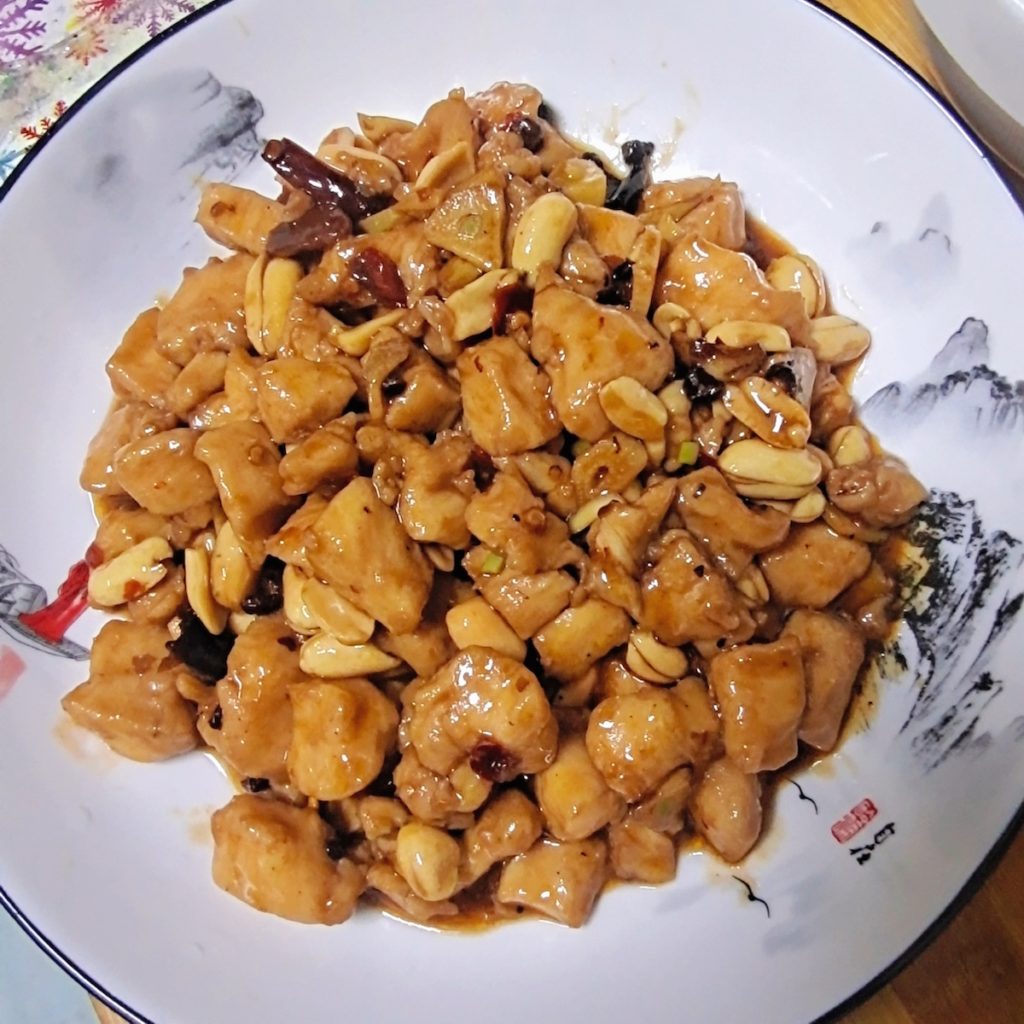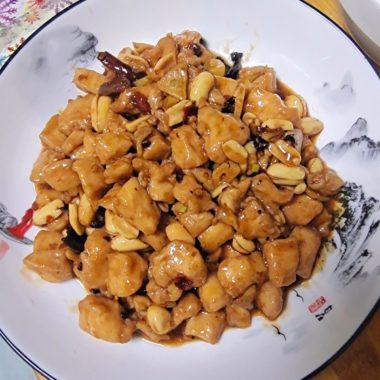On my Chinese Home Kitchen, we have a family version of Kung Pao Chicken. When cooking in the family kitchen, we can finish this dish simply. So do you know how we cook Kung Pao Chicken in a professional kitchen? Guess what kind of Kung Pao Chicken you will see on the restaurant table.

I learned this recipe in the New Oriental Cooking School. It is new to me. The difference between professional style Kung Pao Chicken and the home style version is the processing of the chicken, which makes the chicken taste more tender, and the added seasoning. The use of sugar and vinegar makes the taste 40% sour, 40% sweet, and 20% salty. These three flavors mix together to become a very unique flavor.


Kung Pao Chicken, Professional Style
Equipment
- 1 wok
- 1 wire kitchen strainer
- 1 heat safe container for hot oil
- 1 spatula
Ingredients
- 1 chicken breast
Auxiliary ingredients:
- 2 scallions
- 1 tbsp fresh ginger
- 3 cloves garlic
- ⅓ cup fried peanuts
- 5 xiao mi la (millet) chili peppers
- 10 Sichuan peppercorns
Chicken marinade
- salt to taste
- ½ tbsp sugar, white (granulated)
- 1 tsp dark soy sauce
- 1 tsp corn starch
- ½ tbsp water
Seasonings in pan (adjust to taste)
- msg optional
- ½ tbsp sugar, white (granulated)
- 1 tsp Shaoxing wine (substitute white cooking wine)
- 2 tsp Pixian Doubanjiang bean paste
- 1 pickled red pepper chao tian jiao or xiao mi la
- 1 tsp Baoning vinegar (substitute white vinegar)
- 1 tsp light soy sauce
- starch water 1:1 starch and water
- water enough to cover bottom of pan
Instructions
Preparation:
- Wash the chicken breast and green onions. Peel and wash the ginger and garlic.
- Dice the chicken into cubes.
- Place the chicken in a bowl. Add some sugar, monosodium glutamate, dark soy sauce, and a small amount of water and stir well. Then add starch and stir. Set aside.salt, ½ tbsp sugar, white (granulated), msg, 1 tsp dark soy sauce, 1 tsp corn starch, ½ tbsp water
- Chop the green onion, ginger and garlic. Remove the skin of the peanuts. Chop the pickled peppers and bean paste together.1 pickled red pepper, 2 tsp Pixian Doubanjiang bean paste
Cooking:
- Add enough oil to the wok to cover the chicken, and heat the oil to 90-120° C (194-248° F). Blanch the chicken in the hot oil.1 chicken breast
- When the chicken changes color, remove the chicken and set aside. Pour the hot oil into a heat-resistant container.
- Add a small amount of oil to the wok. Then add the Sichuan peppercorns and dried red peppers, and fry until you smell the aroma.10 Sichuan peppercorns, 5 xiao mi la (millet) chili peppers
- Next, add the ginger, garlic, Doubanjiang bean paste and pickled pepper mixture, and cooking wine. Stir fry evenly, then add an appropriate amount of water (just enough to dissolve the salt and sugar) and season with salt, sugar, MSG, vinegar, and light soy sauce. (NOTE: The finished dish should not have a lot of broth, so add water sparingly.)1 tbsp fresh ginger, 3 cloves garlic, ⅓ cup fried peanuts, salt, msg, 1 tsp Shaoxing wine, 2 tsp Pixian Doubanjiang bean paste, 1 pickled red pepper, 1 tsp Baoning vinegar, 1 tsp light soy sauce, water, ½ tbsp sugar, white (granulated)
- Add the diced chicken, stir fry, then glaze (Daqian) with starch water. Add a small amount of oil to brighten.starch water
- Finally, add the peanuts and green onions.⅓ cup fried peanuts, 2 scallions
- Turn off the heat, and stir-fry the chicken and peanuts evenly.
Notes
- Adjust the amount of seasonings according to the amount of your ingredients. The taste of this dish should be salty and slightly sweet and sour.
- When blanching the chicken, turn the chicken when the color changes slightly to avoid the chicken pieces from sticking together. Please be careful with the hot oil.
- Pickled peppers and Doubanjiang bean paste are both salty, so please be sure to test the taste of this dish during the cooking process.
Nutrition
Do you enjoy My Chinese Home Kitchen?
We enjoy sharing these authentic home recipes with you. To learn more about My Chinese Home Kitchen, please visit our About page.
Please leave a comment, or SUBSCRIBE to our newsletter.
For more of our original videos, visit My Chinese Home Kitchen on YouTube and Rumble.










